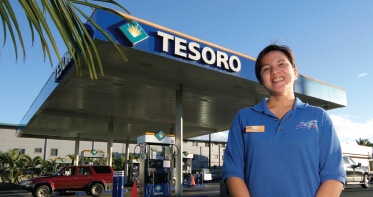
Earlier this month, after a year-long unsuccessful effort to sell the facility, Tesoro announced they were shutting down their refinery while continuing to offer it for sale. The question on everyone’s mind—what does this mean for Hawai‘i?
This 3-part series by UHERO Graduate Assistants Iman Nasseri and Sherilyn Wee attempts to answer those questions.
Part 1: Hawai‘i’s Oil Market
Part 2: Why did Tesoro close instead of Chevron?
Part 3: How will this affect gasoline and other prices?
PART 1: HAWAI’I’S OIL MARKET: A TALE OF TWO REFINERIES
Hawai‘i is an extremely small part of global oil markets (almost 90 million barrels per day). Hawai‘i consumes 100-145 thousand barrels per day (kb/d) of petroleum products with fluctuations since the early 1980s. Currently the state has two small refineries: Chevron and Tesoro. Chevron’s Hawai‘i refinery was built in 1962 to supply the growing fuel market in Hawai‘i. Its crude distillation capacity was initially 33 kb/d, but has since been expanded to 54 kb/d. The Tesoro refinery was built as a 30 kb/d facility in 1970 by a company called Pacific Resources International (PRI). That facility changed hands twice—in 1989 to BHP, an Australian mining and oil company, and again in 1998 to Tesoro. After being upgraded and expanded several times, the refinery’s capacity is now nearly 94 kb/d, 75% larger than the Chevron facility.
The total refining capacity of both facilities, nearly 150 kb/d, has exceeded Hawai‘i’s demand for refined products for quite some time, and Hawai‘i’s demand for oil is actually expected to shrink further due to a variety of factors. One factor affecting the prospects for Hawai‘i’s petroleum market is the Hawai‘i Clean Energy Initiative (HCEI), whose express purpose is to gradually wean Hawai‘i’s economy off oil. Other factors include, but are not limited to, the possible introduction of Liquefied Natural Gas (LNG) into Hawai‘i’s energy mix, existing and future environmental regulations that may limit the use of petroleum products (such as burning fuel oil to produce electricity and/or marine transportation), increased EV penetration and improved fuel economy in the ground transportation sector, and flat to moderate economic and population growths in short- to medium-term future.
In addition, in today’s worldwide refining industry, the most profitable facilities have the following characteristics:
- large[1] enough to achieve economies of scale
- small enough relative to the local market to sell all of its production in the local market regardless of its operating strategy
- in a market where imports of all products are required (to have a natural price floor through import-parity pricing).
Hawai‘i’s refineries do not enjoy any of these conditions!
Taken as a whole, it is clear that the closure of at least one of Hawai‘i’s refineries was expected, and baring some significant improvement in the local refining industry, Chevron may very well follow Tesoro’s conversion to an import facility.
[1] Current average-sized refinery worldwide is about 400 kb/d
Disclaimer: Blog posts are intended to stimulate discussion and critical comment. The views expressed in this article are those of the author.